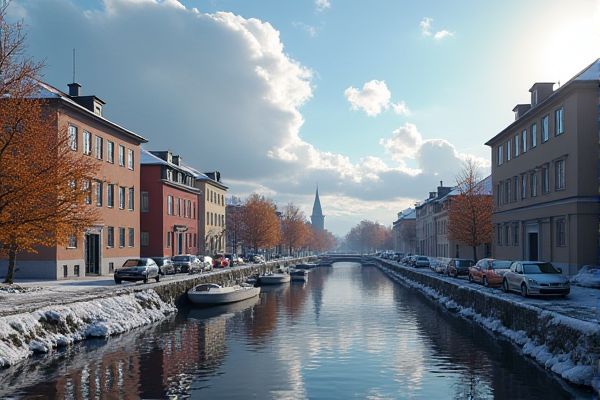
Housing market and best cities to live in Finland: Housing market trends. Average home prices. Rental market insights. Cost of living. Popular neighborhoods. Urban vs rural living. Quality of education. Transportation and connectivity. Job market opportunities. Healthcare accessibility.
Housing market trends.
Finland's housing market remains subdued due to rising interest rates and a struggling economy, with house prices falling by over 10% since their summer 2022 peak. Forecasts indicate further declines, particularly in the Greater Helsinki Area. For more detailed insights, you can explore the comprehensive analysis on the Global Property Guide.
Average home prices.
The average house price per square meter in Finland is EUR 1,767, but prices vary significantly by location. In the Greater Helsinki area, the average price rises to EUR 3,728 per square meter, reflecting the premium associated with urban living. In contrast, southern Finland offers a more moderate average of EUR 2,061 per square meter. Interestingly, [northern and eastern Finland](https://www.finnwards.com/living-in-finland/house-prices-in-finland/) stand out as the most affordable regions, with prices hovering around EUR 1,300 to EUR 1,313 per square meter, providing more budget-friendly options for potential homeowners.
Rental market insights.
In Finland, the rental market is characterized by low to moderate returns, with average gross rental yields of 4.24% in Q3 2023. Rents have risen modestly, with the average monthly rent at EUR15.02 per square meter, and private rents in Helsinki averaging EUR20.86 per square meter. However, demand is plummeting due to high inflation and rising interest rates. For more detailed insights, visit the Global Property Guide to understand the dynamics of Finland's property market.
Cost of living.
In Finland, housing costs are a significant consideration for residents, with the average rent being approximately EUR15 per m2, though it can range from EUR10-30 per m2. The average cost of owner-occupied homes is around EUR2,300 per m2, but prices vary widely depending on location, with larger cities generally being the most expensive. These housing expenses can account for about one-fifth of a Finn's net income. Moreover, residents must also consider additional costs such as water, electricity, home insurance, and internet. For more detailed information on living arrangements and housing in Finland, the InfoFinland website provides comprehensive guidance on accommodation options and costs.
Popular neighborhoods.
Helsinki is a city of vibrant and diverse neighborhoods, each offering a unique experience for visitors and residents alike. Among the most popular areas, Kaartinkaupunki stands out with its trendy hotels and chic dining options, making it a favorite for those seeking modern accommodations and cuisine. Kamppi acts as a bustling hub for nightlife and shopping, providing ample opportunities to explore the city's dynamic urban scene. Meanwhile, Punavuori offers an authentic Finnish atmosphere, with its charming shops and beautiful Art Nouveau buildings. Beyond these, the hipster district of Kallio impresses with its affordable living and spirited nightlife, appealing to a younger crowd searching for an energetic community. The area of Vallila, affordable yet rich with Nordic classic architecture, and the central district of Toolo, known for its important buildings and trendy cafes, also contribute to Helsinki's reputation as a city full of charm and character. For those interested in an in-depth exploration of where to stay in this captivating city, Adventourely offers a comprehensive guide on the best neighborhoods and accommodations, ensuring a memorable experience in the Finnish capital.
Urban vs rural living.
The housing market in Finland is currently weak, with prices and transactions declining, especially in urban areas like Greater Helsinki where prices dropped by 3.95% year-over-year to Q3 2023. Urban areas, despite their higher costs, offer more job opportunities and amenities, while rural areas are less expensive but lack the same level of economic and social infrastructure. For a more comprehensive overview of the market trends, visit the Global Property Guide for detailed insights into Finland's property price history.
Quality of education.
For quality of education, cities like Helsinki, Turku, and Tampere stand out in Finland, offering excellent education and healthcare systems, with Helsinki and Turku being particularly noted for their high standards and historical educational institutions. However, the current housing market in Finland has come to a standstill due to higher interest rates, with prices of existing dwellings dropping significantly since 2022, though recovery is expected in the latter part of 2024. Discover more about the Best Places To Live In Finland and how these cities continue to thrive despite economic challenges.
Transportation and connectivity.
Helsinki stands out as the best city in Finland for transportation and connectivity, topping global rankings for urban mobility due to its extensive public transport, electric vehicle infrastructure, and pedestrian-friendly streets. Other notable cities like Tampere and Turku also offer good connectivity, with Tampere being well-connected to Helsinki via high-speed rail and Turku providing excellent public transport and river activities. For more insights on urban transportation, explore the comprehensive information available on the World Economic Forum website.
Job market opportunities.
Finland's job market is robust, with high demand for skilled professionals in cities like Helsinki, Turku, Espoo, Tampere, Oulu, and others, particularly in sectors such as IT, engineering, healthcare, and finance. These sectors are known for offering flexible work arrangements and high-paying salaries. For a deeper insight into this dynamic market, you might explore the comprehensive Job Outlook for Finland.
Healthcare accessibility.
In Finland, the best cities to live in terms of healthcare accessibility include Helsinki and other major urban areas, as they are well-integrated into the highly decentralized three-level publicly funded healthcare system. This system ensures that everyone, including those in different socioeconomic groups, has access to primary, secondary, and tertiary care, with general practitioners acting as gatekeepers to more specialized services. For more detailed insights into the structure and specifics of this system, visit the Healthcare in Finland page.
